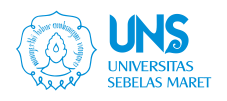KESESUAIAN PENERAPAN KONSEP PARIWISATA KREATIF DI DESA BABAGAN, KABUPATEN REMBANG
Abstract
Full Text:
PDFReferences
Ardhala, A. D., Santoso, E. B., & Sulistyarso, H. (2016). Influence Factors on the Development of Creative Industry as a Tourism Destination (Case Study: Footwear Village in Mojokerto City). Procedia - Social and Behavioral Sciences, 227, 671-679. https://doi.org/10.1016/j.sbspro.2016.06.131
Ariyora, Yuan K.S., Budisusanto, Y., & Prasasti, I. (2015). Pemanfaatan Data Penginderaan Jauh Dan Sig Untuk Analisa Banjir (Studi Kasus: Banjir Provinsi Dki Jakarta). Jurnal GEOID, 10(2), 137-146.
Buhalis, D. (2000). Marketing the competitive destination of the future: Growth strategies for accommodation establishments in alpine regions. Tourism Management, 21(1), 97–116. https://doi.org/10.1016/S0261-5177(99)00095-3
Darmawan. 2013. Metode Penelitian Kuantitatif. Bandung: Remaja Rosdakarya
Dias, Á., Gonzalez-Rodriguez, M. R. & Patuleia, M. (2023). Creative tourism destination competitiveness: An integrative model and agenda for future research. Creative Industries Journal. 16 (2), 180-203.
Florida, R. (2003). Cities and Creative Class. City and Community.
Florida, R. (2007). The Rise of The Creative Class and How It's Transforming Work. Moscow: Classic-XXI century.
Hermantoro, Henky. (2011). Creative-Based Tourism. Aditri, Cinere Depok.
Landry, C. (2008). The Creative City : A Toolkit for Urban Innovators. London: Eartscan.
Martini, L. (2016). Knowledge Sharing in a Creative City. Procedia Computer Science, 79-90.
Mathieson, A., & Wall, G. (1982). Tourism, economic, physical and social impacts. Miscellaneous: Tourism, economic, physical and social impacts., 208pp.
Muarifuddin. (2017). Implementasi Pembangunan Desa Wisata Batik Desa Babagan Kecamatan Lasem Kabupaten Rembang. Jurnal Pendidikan dan Pemberdayaan Masyarakat, 4(1), 51-70.
Mulyana, D. (2005). Ilmu Komunikasi: Suatu Pengantar. Bandung: Remaja Rosdakarya.
Ohridska-Olson, R. V., & Ivanov, S. H. (2010). Creative Tourism Business Model and its Application in Bulgaria.
Raymond, C. (2007). Creative Tourism New Zealand: The practical challenges of developing creative tourism. In G. Richards & J. Wilson (Eds.), Tourism, creativity, and development (pp.145–157). Routledge
Remoaldo, P., & Ribeiro, J. C. (2019). Creative Tourism as a New Challenge to the Development of Destinations: The Portuguese Case Study: A Path to Entrepreneurship and Innovation. In M. Peris-Ortiz, M. R. Cabrera-Flores, & A. Serrano-Santoyo (Eds.), Cultural and Creative Industries: A Path to Entrepreneurship and Innovation (pp. 81-99). Springer. https://doi.org/10.1007/978-3-319-99590-8_5
Richards, G. & Raymond, C. (2000). Creative Tourism. ATLAS news (23), 16-20.
Richards, G. (2011). Creativity and tourism: The State of the Art. Annals of Tourism Research, 38(4), 1225-1253.
Richards, G. (2018). Cultural tourism: A review of recent research and trends. Journal of Hospitality and Tourism Management, 36, 12–21. https://doi.org/10.1016/j.jhtm.2018.03.005
Richards, G. (2020). Designing creative places: The role of creative tourism. Annals of Tourism Research, 85, 102922. https://doi.org/10.1016/j.annals.2020.102922
Ristiani, E., & Haryati, T. (2016). Pengaruh tenaga kerja dan persaingan usaha terhadap produktivitas usaha batik tulis di Desa Babagan Kecamatan Lasem Kabupaten Rembang. Economic Education Analysis Journal, 5(3). http://journal.unnes.ac.id/sju/index.php/eeaj
Ross, D., Saxena, G., Correia, F., & Deutz, P. (2017). Archaeological tourism: A creative approach. Annals of Tourism Research, 67, 37-47.
Sagala, S. (2005). Konsep dan Makna Pembelajaran. Bandung: Alfabeta.
Silvandi, G. O., & Mandalia, S. (2022). Pengembangan Taman Margasatwa dan Budaya Kinantan dengan menerapkan aspek pariwisata 3S (Something to See, Something to Do, Something to Buy). i-Tourism: Jurnal Pariwisata Syariah, 1(2), Article 2. https://doi.org/10.31958/i-tourism.v1i2.4923
Simanjuntak, B. A., Tanjung, F., & Nasution, R. (2017). Sejarah pariwisata: menuju perkembangan pariwisata Indonesia.Yayasan Pustaka Obor Indonesia.
Sugiyono. (2007). Statistika Untuk Penelitian. Bandung: Alfabeta.
Tavallaee, S., Asadi, A., Aby, H., & Ebrahimi, M. (2014). Tourism planning: An integrated and sustainable development approach. Management Science Letters, 4, 2495–2502.
UNESCO Creative Cities Network. (2006). Towards sustainable strategies for creative tourism: Discussion report of the planning meeting for the 2008 International Conference on Creative Tourism, Santa Fe, New Mexico, U.S.A., October 25–27, 2006 (CLT/CEI/CID/2008/RP/66). United Nations Educational, Scientific and Cultural Organization.
Refbacks
- There are currently no refbacks.


